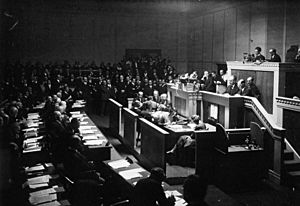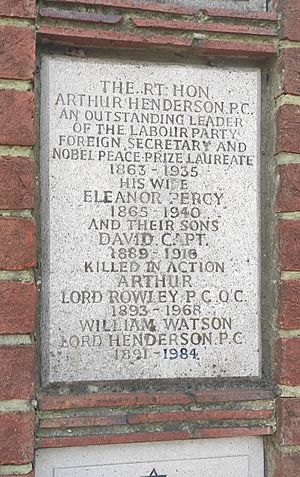Arthur Henderson facts for kids
Quick facts for kids
Arthur Henderson
|
|||||||||||||||||||||||||||||||||||||||||||||
|---|---|---|---|---|---|---|---|---|---|---|---|---|---|---|---|---|---|---|---|---|---|---|---|---|---|---|---|---|---|---|---|---|---|---|---|---|---|---|---|---|---|---|---|---|---|

Henderson circa 1910-15
|
|||||||||||||||||||||||||||||||||||||||||||||
| Leader of the Opposition | |||||||||||||||||||||||||||||||||||||||||||||
| In office 1 September 1931 – 25 October 1932 |
|||||||||||||||||||||||||||||||||||||||||||||
| Prime Minister | Ramsay MacDonald | ||||||||||||||||||||||||||||||||||||||||||||
| Preceded by | Stanley Baldwin | ||||||||||||||||||||||||||||||||||||||||||||
| Succeeded by | George Lansbury | ||||||||||||||||||||||||||||||||||||||||||||
| Leader of the Labour Party | |||||||||||||||||||||||||||||||||||||||||||||
| In office 28 August 1931 – 25 October 1932 |
|||||||||||||||||||||||||||||||||||||||||||||
| Deputy | John Robert Clynes | ||||||||||||||||||||||||||||||||||||||||||||
| Preceded by | Ramsay MacDonald | ||||||||||||||||||||||||||||||||||||||||||||
| Succeeded by | George Lansbury | ||||||||||||||||||||||||||||||||||||||||||||
| In office 5 August 1914 – 24 October 1917 |
|||||||||||||||||||||||||||||||||||||||||||||
| Chief Whip | Frank Goldstone George Henry Roberts |
||||||||||||||||||||||||||||||||||||||||||||
| Preceded by | Ramsay MacDonald | ||||||||||||||||||||||||||||||||||||||||||||
| Succeeded by | William Adamson | ||||||||||||||||||||||||||||||||||||||||||||
| In office 22 January 1908 – 14 February 1910 |
|||||||||||||||||||||||||||||||||||||||||||||
| Chief Whip | George Henry Roberts | ||||||||||||||||||||||||||||||||||||||||||||
| Preceded by | Keir Hardie | ||||||||||||||||||||||||||||||||||||||||||||
| Succeeded by | George Barnes | ||||||||||||||||||||||||||||||||||||||||||||
| Secretary of State for Foreign Affairs | |||||||||||||||||||||||||||||||||||||||||||||
| In office 7 June 1929 – 24 August 1931 |
|||||||||||||||||||||||||||||||||||||||||||||
| Prime Minister | Ramsay MacDonald | ||||||||||||||||||||||||||||||||||||||||||||
| Preceded by | Austen Chamberlain | ||||||||||||||||||||||||||||||||||||||||||||
| Succeeded by | The Marquess of Reading | ||||||||||||||||||||||||||||||||||||||||||||
| Chief Whip of the Labour Party | |||||||||||||||||||||||||||||||||||||||||||||
| In office 1925–1927 |
|||||||||||||||||||||||||||||||||||||||||||||
| Leader | Ramsay MacDonald | ||||||||||||||||||||||||||||||||||||||||||||
| Preceded by | Ben Spoor | ||||||||||||||||||||||||||||||||||||||||||||
| Succeeded by | Tom Kennedy | ||||||||||||||||||||||||||||||||||||||||||||
| In office 1920–1924 |
|||||||||||||||||||||||||||||||||||||||||||||
| Leader | John Robert Clynes Ramsay MacDonald |
||||||||||||||||||||||||||||||||||||||||||||
| Preceded by | William Tyson Wilson | ||||||||||||||||||||||||||||||||||||||||||||
| Succeeded by | Ben Spoor | ||||||||||||||||||||||||||||||||||||||||||||
| In office 1914–1914 |
|||||||||||||||||||||||||||||||||||||||||||||
| Leader | Ramsay MacDonald | ||||||||||||||||||||||||||||||||||||||||||||
| Preceded by | George Henry Roberts | ||||||||||||||||||||||||||||||||||||||||||||
| Succeeded by | Frank Walter Goldstone | ||||||||||||||||||||||||||||||||||||||||||||
| In office 8 February 1906 – 1907 |
|||||||||||||||||||||||||||||||||||||||||||||
| Preceded by | David Shackleton | ||||||||||||||||||||||||||||||||||||||||||||
| Succeeded by | George Henry Roberts | ||||||||||||||||||||||||||||||||||||||||||||
| Home Secretary | |||||||||||||||||||||||||||||||||||||||||||||
| In office 23 January 1924 – 4 November 1924 |
|||||||||||||||||||||||||||||||||||||||||||||
| Prime Minister | Ramsay MacDonald | ||||||||||||||||||||||||||||||||||||||||||||
| Preceded by | William Bridgeman | ||||||||||||||||||||||||||||||||||||||||||||
| Succeeded by | Sir William Joynson-Hicks | ||||||||||||||||||||||||||||||||||||||||||||
| Minister without Portfolio | |||||||||||||||||||||||||||||||||||||||||||||
| In office 10 December 1916 – 12 August 1917 |
|||||||||||||||||||||||||||||||||||||||||||||
| Prime Minister | David Lloyd George | ||||||||||||||||||||||||||||||||||||||||||||
| Preceded by | The Marquess of Lansdowne | ||||||||||||||||||||||||||||||||||||||||||||
| Succeeded by | George Nicoll Barnes | ||||||||||||||||||||||||||||||||||||||||||||
| Paymaster-General | |||||||||||||||||||||||||||||||||||||||||||||
| In office 18 August 1916 – 10 December 1916 |
|||||||||||||||||||||||||||||||||||||||||||||
| Prime Minister | H. H. Asquith | ||||||||||||||||||||||||||||||||||||||||||||
| Preceded by | Thomas Legh | ||||||||||||||||||||||||||||||||||||||||||||
| Succeeded by | Joseph Compton-Rickett | ||||||||||||||||||||||||||||||||||||||||||||
| President of the Board of Education | |||||||||||||||||||||||||||||||||||||||||||||
| In office 25 May 1915 – 18 August 1916 |
|||||||||||||||||||||||||||||||||||||||||||||
| Prime Minister | H. H. Asquith | ||||||||||||||||||||||||||||||||||||||||||||
| Preceded by | Jack Pease | ||||||||||||||||||||||||||||||||||||||||||||
| Succeeded by | Robert Crewe-Milnes | ||||||||||||||||||||||||||||||||||||||||||||
|
|||||||||||||||||||||||||||||||||||||||||||||
| Personal details | |||||||||||||||||||||||||||||||||||||||||||||
| Born | 13 September 1863 Glasgow, Scotland |
||||||||||||||||||||||||||||||||||||||||||||
| Died | 20 October 1935 (aged 72) London, England |
||||||||||||||||||||||||||||||||||||||||||||
| Political party | Labour | ||||||||||||||||||||||||||||||||||||||||||||
Arthur Henderson (born September 13, 1863 – died October 20, 1935) was an important British Labour politician. He started his career as an iron moulder, which is a person who shapes metal.
Henderson made history as the first Labour Party member to join the Cabinet, which is a group of top government ministers. He also won the Nobel Peace Prize in 1934 for his work towards peace. What's special about him is that he led the Labour Party three separate times in three different decades. People called him "Uncle Arthur" because he was known for being honest and calm.
Contents
Early Life and Work
Arthur Henderson was born in Glasgow, Scotland, in 1863. His father, a textile worker, died when Arthur was only ten years old. After this, his family moved to Newcastle upon Tyne in England.
At age twelve, Arthur started working at a factory called Robert Stephenson and Sons' General Foundry Works. He became an iron moulder.
In 1879, Henderson became a Methodist, a type of Christian. He later became a Local Preacher, someone who gives sermons. When he lost his job in 1884, he focused more on his preaching.
Becoming a Union Leader
In 1892, Henderson became involved in trade union politics. He was chosen to be a paid organiser for the Friendly Society of Iron Founders, a union for metalworkers. He also worked on a board that helped solve problems between workers and employers.
Henderson believed that strikes often caused more problems than they solved. He tried to avoid them whenever he could. Because of this, he didn't support the creation of the General Federation of Trade Unions. He thought it would lead to more strikes.
Joining the Labour Party
In 1900, Arthur Henderson was one of 129 people who helped create the Labour Representation Committee (LRC). This group later became the Labour Party.
In 1903, Henderson became the Treasurer of the LRC. He was also elected as a Member of Parliament (MP) for Barnard Castle. An MP is a person elected to represent a group of people in the UK Parliament. From 1903 to 1904, Henderson was also the mayor of Darlington, County Durham.
In 1906, the LRC changed its name to the Labour Party. They won 29 seats in the general election. In 1908, Henderson became the Leader of the Labour Party, taking over from Keir Hardie. He held this role until 1910.
Serving in the Cabinet
When the First World War started in 1914, Ramsay MacDonald resigned as Labour Party Leader. Henderson was chosen to lead the party again.
In 1915, Prime Minister H. H. Asquith formed a coalition government, which means different political parties worked together. Henderson became the first Labour Party member to join the Cabinet. He was made President of the Board of Education, which was in charge of schools.
In 1916, David Lloyd George became Prime Minister. Henderson joined his small War Cabinet as a Minister without Portfolio. This meant he was a minister without a specific department. Henderson resigned in 1917 because his idea for an international meeting about the war was not accepted by the Cabinet.
After leaving the Cabinet, Henderson worked hard to make the Labour Party stronger. He helped create local groups for the party across the country. He also helped write "Labour and the New Social Order," a plan for the party's future. This plan talked about making sure everyone had a good standard of living, taking important industries under government control, and taxing rich people more.
The 1920s and Beyond
Henderson lost his MP seat in the 1918 election but won it back in 1919 for Widnes. He then became Labour's Chief Whip, a role that makes sure party members vote as a group.
He lost his seat again in 1922 and 1923, but each time he won it back in a by-election. A by-election is a special election held to fill a vacant seat. In 1924, he won a by-election for Burnley.
In 1924, when Labour formed its first-ever government with Ramsay MacDonald as Prime Minister, Henderson became the Home Secretary. This job is in charge of law and order and security within the country. This government didn't last long, and Labour lost the next election.
Even though he was very respected, Henderson chose not to challenge MacDonald for the party leadership. He wrote a pamphlet called Labour and the Nation to explain the party's goals and prevent disagreements within the party.
Foreign Secretary
In 1929, Labour formed another government, and MacDonald made Henderson the Foreign Secretary. This job is about dealing with other countries. Henderson worked to reduce tensions in Europe after the First World War. He helped Britain become friends with the USSR again and strongly supported the League of Nations, an organization that aimed to promote peace.
A Difficult Time
The Great Depression caused big problems for the government. There were disagreements about cutting unemployment benefits to save money. Henderson disagreed with Prime Minister MacDonald on this issue.
In August 1931, the Labour government resigned. King George V asked MacDonald to form a new government with members from all parties, called a National Government. MacDonald agreed, but the Labour Party did not support this. They expelled MacDonald and his supporters from the party. Henderson was the only one who voted against expelling them.
Henderson then became the leader of the main Labour Party. He led them into the general election in October 1931. It was a very bad election for Labour, and they lost many seats. Henderson also lost his own seat in Burnley. The next year, he stepped down as party leader.
Later Life and Peace Work
Henderson returned to Parliament in 1933 after winning another by-election for Clay Cross. He holds a record for being elected five times in by-elections for different areas.
For the rest of his life, Henderson worked to prevent another world war. He chaired the Geneva Disarmament Conference, which tried to get countries to reduce their weapons. In 1934, he was given the Nobel Peace Prize for his efforts. Sadly, his Nobel medal was stolen in 2013.
Arthur Henderson died in 1935 at the age of 72. His eldest son, David, was killed in the First World War. His other two sons, William and Arthur, also became Labour politicians.
You can find Arthur Henderson's papers and records at the Labour History Archive and Study Centre in Manchester.
See Also
 In Spanish: Arthur Henderson para niños
In Spanish: Arthur Henderson para niños
- List of peace activists




